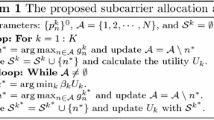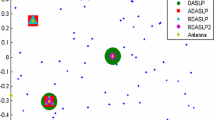Abstract
An optimum downlink power control that maximizes the user-capacity of a Direct Sequence-Code Division Multiple Access (DS-CDMA) cellular system is proposed based on a convex programming method. First, the downlink beamforming weights for the base-station antenna-array are designed based on the maximum Signal-Interference-Ratio (SIR) criterion. Then by optimizing the downlink power subject to a fixed total transmit power constraint, we further increase the Signal-Interference-Noise-Ratio (SINR) at the mobile terminal, thus increasing the capacity of the system. With the same methodology, we can also minimize the required transmit power while satisfying the SINR threshold constraints. Additionally, a robust downlink power control approach for mitigating the performance degradation due to channel estimates error is also proposed. Computer simulations are given to demonstrate the improvement of downlink capacity, received SINR, robustness, and the minimization of the required transmit power for a DS-CDMA system with antenna-array at the base-station.
Similar content being viewed by others
References
A.J. Viterbi, CDMA: Piinciples of Spread Spectrum Communication, Massachusetts: Addison-Wesley, 1995.
K.S. Gilhousen, I.M. Jacobs, R. Padovani, A. Viterbi, L.A. Weaver, and C. Wheatly, “On the Capacity of a Cellular CDMA System,”IEEE Trans. Veh. Technol.,vol. 40, no. 2, 1991, pp. 303–312.
A.F. Naguib and A. Paulraj, “Performance of Wireless CDMA with Mary orthogonal Modulation and Cell Site Antenna Arrays,” IEEE J. Select. Areas Commun.,vol. 14, no. 9, 1996, pp. 1770–1783.
S. Simanapalli, “Adaptive Array Methods for Mobile Communications,” in Proc. VTC'94, Stockholm, Sweden, June 1994.
F. Rashid-Farrokhi, K.J.R. Liu, and L. Tassiulas, “Transmit Beamforming and Power Control for Cellular Wireless Systems,” J. Select. Areas Commun.,vol. 16, 1998, pp. 1437–1449.
Y.C. Liang, F.P.S. Chin, and K.J.R. Liu, “Downlink beam forming for DS-CDMA Mobile Radio with Multimedia Services,” IEEE Trans. on Commun.,vol. 49, no. 7, 2001, pp. 1288–1298.
Y.C. Liang and F. Chin, “Transmit Antenna Array Techniques for Cellular CDMA Systems,” in Proc. of Ninth Int. Symp. on PIMC, Boston, MA, USA, Sept. 1998.
S. Boyd and L. Vandenberghe, Convex Optimization, Cambridge, U.K.: Cambridge Press, 2004.
L. Vandenberghe, S. Boyd, and S.P. Wu, “Determinant maximization with Linear Matrix Inequality Constraints,” SIAM J. Matrix Anal. Appl.,vol. 19, no. 2, 1998, pp. 499–533.
M. Lobo, L. Vandenberghe, and S. Boyd, Second-Order Cone Programming, http://www.stanford.edu/boyd/SOCP.html.
S. Tanaka, M. Sawahashi, and F. Adachi, “Pilot Symbol-Assisted Decision-Directed Coherent Adaptive Array Diversity for DS-CDMA Mobile Radio Reverse Link,” IEICE Trans. Fundamentals,vol. E80-A, no. 12, 1997, pp. 2445–2453.
Author information
Authors and Affiliations
Rights and permissions
About this article
Cite this article
Tung, TL., Yao, K. Optimum Downlink Power Control of a DS-CDMA System via Convex Programming. The Journal of VLSI Signal Processing-Systems for Signal, Image, and Video Technology 39, 133–146 (2005). https://doi.org/10.1023/B:VLSI.0000047276.31162.64
Published:
Issue Date:
DOI: https://doi.org/10.1023/B:VLSI.0000047276.31162.64




